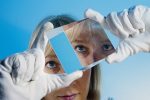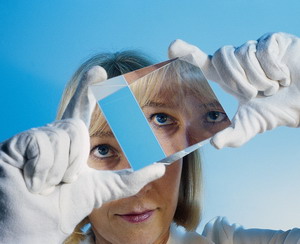The movie magazine Cinema reported that, “This isn’t a movie that people watch, but rather experience,” on James Cameron’s “Avatar – Return to the World”. The viewer dives into a fascinating world that has never been shown more realistically or brilliantly ever before. This cinema experience is intensified by a three-dimensional presentation in which everything appears to be within reach and the spatial depth can be felt on the large screen. This type of 3-D presentation is made possible by digital projection.
In order to be able to illuminate a picture that is 30 meters in width with the same exact precision, the movie projector has to be able to deliver a luminous flux of 27,000 lumens or more. This requires a strong light source. A color filter prism made of highly transparent glass separates its white light into the color components Red, Green, and Blue (RGB) and directs it onto optical semiconductors. These reflect the light onto the lens of the projector with the help of up to two million individually steerable micromirrors that present the film to the viewing audience in its full clarity.
SCHOTT has now developed a version of its N-BK7 glass that offers extremely high transmission (HT) especially for the prisms used in digital projectors. The new N-BK7HT guarantees a minimum transmission of 99.6% at a wavelength of 400 nm and a thickness of 25 mm. Within the visible spectrum range of between 400 and 700 nm, the absorption coefficient is three times lower than with standard N-BK7. This means less heat is generated and the risk of image errors is much lower.
SCHOTT continually works on improving the properties of its glasses and expanding the range of possibilities with respect to processing. In addition, being able to offer sound advice on applications provides the basis for the success of SCHOTT. By expanding its prism manufacturing capabilities, the international technology group is not only in a position to produce the appropriate raw glass products, but also polished or coated prisms, for instance, of up to 200 mm in size. With smaller dimensions, surfaces with a flatness of up to λ/10 and quality of up to 20/10 (Scratch & Dig) can be achieved. In addition, prisms can be coated according to our customer’s needs, for example with dichroic or anti-reflective coatings.
N-BK7 and N-BK7HT are suited for manufacturing highly homogenous optical components of up to 1 meter in diameter. Highly transparent N-BK7HT is also ideal for use in components in which light needs to travel inside the material for distances of up to 150 mm and more, like prisms, for example. Even when exposed to solar radiation with a UV portion, the properties of this glass change only very slightly. It is therefore ideally suited for use in concentrator photovoltaics as well.
SCHOTT AG will also be presenting other innovations at its booth D12 in hall 3 at this year’s OPTATEC.


